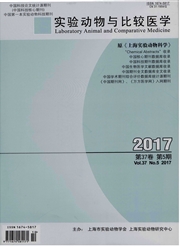

 中文摘要:
中文摘要:
目的探讨球后静脉注射在裸小鼠纳米粒静脉给药中的可行性。方法成年裸小鼠8只,随机分成2组,每组4只,分别通过尾静脉及球后静脉注射超顺磁性氧化铁(superparamagnetici ron oxide,SPIO)纳米粒,行裸小鼠肝脏磁共振(magnetic resonance,MR)快速自旋回波(fast spin echo,FSE)T2WI扫描,测量同一层面、同一区域肝实质及邻近肌肉在增强前后的信号强度,计算信号强度变化率。结果8只裸小鼠全部穿刺成功。尾静脉穿刺平均耗时8min30s,平均穿刺次数为3.7次;球后静脉窦穿刺平均耗时约3min50S,平均穿刺次数为2.3次。球后静脉及尾静脉两种方法注射纳米粒后肝脏的信号强度变化规律一致,纳米粒注射后即刻、5min、10min、30min、1h及2h的信号强度变化率分别为:尾静脉注射66.78%±5.62%,72.92%±8.41%,73.08%±7.68%,74.06%±7.44%,74.61%±6.28%,73.66%±4.52%;球后静脉注射:69.29%±7.53%,74.86%±5.84%,77.54%土6.47%,78.85%±8.23%,79.05%±4.65%,77.99%±7.73%,两者差异无显著性(P〉0.05)。结论裸小鼠球后静脉穿刺简单、可靠,可以作为尾静脉穿刺以外纳米粒注射的途径。
 英文摘要:
英文摘要:
Objective To explore the feasibility of retrobulbar vein injection of nanoparticles in nude mice. Methods Eight healthy adult nude mice were randomly divided into two groups with four in each group. Superparamagnetic iron oxide nanoparticles (SPIO) were intravenously injected via tail vein and retrobulbar vein, respectively. Magnetic resonance (MR) FSE T2WI were performed on liver of nude mice. The signal intensity (SI) of the liver and adjacent muscles were measured, and the change rate of SI were calculated. Results All the 8 nude mice were punctured successfully. It took an average of 8 minutes 30 seconds and 3.7 times for tail vein puncture, which was larger than that of retrobulbar vein puncture which took an average of 3 minutes 50 seconds and 2.3 times. The liver SI enhancement is consistent between retrobulbar vein injection and tail vein injection. The SI change rate at 0 minute, 5 minute, 10 minute, 30 minute, 1 hour and 2 hour were 66.78% ± 5.62%, 72.92% ± 8.41%, 73.08%± 7.68%, 74.06% ± 7.44%, 74.61% ±6.28%, 73.66% ±4.52% respectively in tail vein injection and 69.29%±7.53%, 74.86%± 5.84%, 77.54% ±6.47%, 78.85%± 8.23%, 79.05% ± 4.65%, 77.99% ± 7.73% respectively in retrobulbar vein injection. The difference was not statistically significant (P〉0.05). Conclusion The intravenous administration of nanoparticles via retrobulbar vein is simpler and efficient, it may be used as a method apart from the tail Vein injection.
 同期刊论文项目
同期刊论文项目
 同项目期刊论文
同项目期刊论文
 期刊信息
期刊信息
